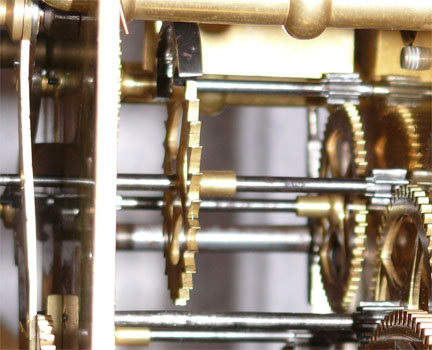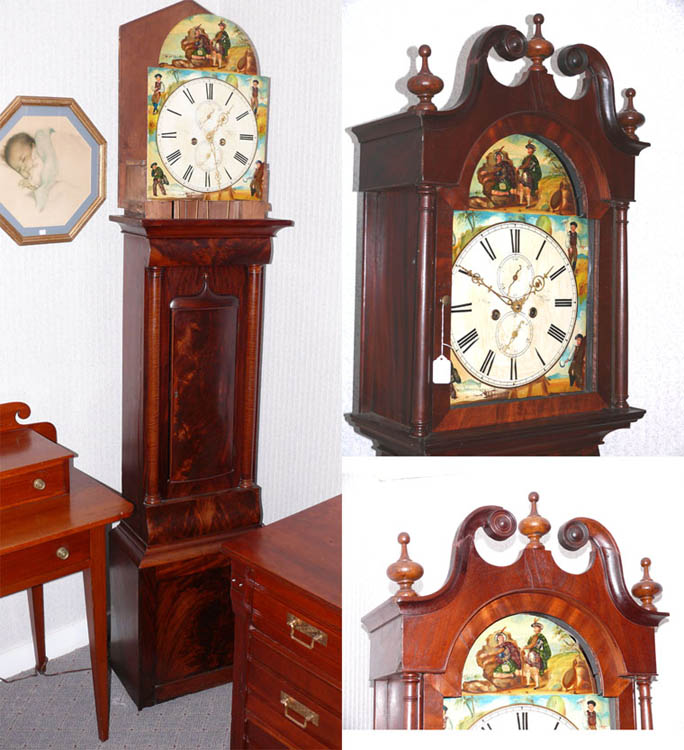
| WWT Shows | CLICK TO: Join and Support Internet Horology Club 185™ | IHC185™ Forums |

|
• Check Out Our... • • TWO Book Offer! • |
Welcome Aboard IHC185™  Internet Horology Club 185
Internet Horology Club 185  IHC185™ Discussion Site Main Page
IHC185™ Discussion Site Main Page  Horological Discussions, Questions and Answers
Horological Discussions, Questions and Answers  Clocks, Including 400-Day Discussions
Clocks, Including 400-Day Discussions  Half-deadbeat escapement?
Half-deadbeat escapement?
 Internet Horology Club 185
Internet Horology Club 185  IHC185™ Discussion Site Main Page
IHC185™ Discussion Site Main Page  Horological Discussions, Questions and Answers
Horological Discussions, Questions and Answers  Clocks, Including 400-Day Discussions
Clocks, Including 400-Day Discussions  Half-deadbeat escapement?
Half-deadbeat escapement?Go  | New Topic  | Find-Or-Search  | Notify  | Tools  | Reply to Post  |  |
I'm looking at a Scottish tallcase clock, circa 1790. It runs, but the seconds hand alternately recoils one second, and stops dead on the next. Is this characteristic of a half-deadbeat escapement, and would such an escapement be appropriate for a Scottish clock of this period? I haven't looked at the escape wheel yet. Norman | |||
|
Hello, Seems like the action of an Anchor escapement to me, Photo' would help settle it, Regards, Ged. | ||||
|
Hello Norman, The action of the escapement is perfectly normal, and as Ged states, your clock will have an 'Anchor' escapement rather than the 'Graham Dead Beat'(which does 'stop dead'). Variously called either a 'Recoil' or an 'Anchor' escapement. In brief, whilst arresting the pendulum at the end of its 'swing', the clock train tries to run backwards momentarily against the weight driving it, an action which the Graham 'Dead Beat' eliminates. John | ||||
|
Thanks Ged and John, I'm familiar with the typical action of recoil and dead beat escapements, as we have clocks with both in the museum where I sometimes work, and I own a skeleton clock with a recoil escapement. The recoil escapements I've seen recoil on BOTH beats, however, and the deadbeat doesn't recoil on EITHER beat. The clock in question recoils on ONE beat, but not the next. I assumed it was out of beat until I mentioned it to a clockmaker yesterday, who suggested it was a half deadbeat escapment. I'll have to go to the shop to look at the escape wheel to see what it has; maybe I'll be able to take pictures. Supposedly the clock was just serviced, so should be in good running order, hence my concern. Thanks, Norman | ||||
|
Norman, I was intrigued enough to do a Google' on the 'Half Deadbeat' escapement, and sure enough it is mentioned on a few hits. An American Ebay seller has listed a clock repair 'How to' book with it mentioned in the text: A Practical Course in Clock Repair How to Book Item number: 280061074854 There's also a video 'How to' which shows an example of it, so maybe it does exist. The escape wheel on the example I found shown looks exactly like the Graham though, but with the cheapo bent steel pallets! Scroll to the bottom of the page and there's an excellent pic' taken from the video being promoted. http://www.ticktockpro.com/PRO%20clock%20repair.htm Certainly not an escapement I've ever heard of before. I don't recall seeing the type mentioned in the British Horological Institute training modules, and I have all 3 grades of both the old course notes and the latest releases. I'll look again in case I missed something! Could it be an 'American' term by any chance? If anyone does know of its existance and how it operates, I'm certainly all 'ears' and willing to learn! Please try to get a photo' of the escapement when you visit the clock! John | ||||
|
The recoil escapement has an escapement error that causes it to run fast in the small arcs. The deadbeat escapement has a, much smaller, escapement error that causes it to run slow in the small arcs. The half-deadbeat escapement is an adjustment to the deadbeat pallets or wheel to introduce a small amount of recoil in an attempt to overcome the escapement error. Escapement error arises from the escapement affecting the acceleration of the pendulum and interfering with its freedom. At least that is how I understand it from the folks in Scientific Horology Chapter 161. | ||||
|
Thanks John & Tom. I returned to the shop today and took pictures of the clock. Turns out to be just a plain old recoil escapement after all; the seller noted my comments the other day, and leveled the clock better, and now it recoils on both beats. As you can see from the picture, the teeth point away from the direction of rotation, like any recoil. John, I'd never heard of a half-deadbeat either, I checked my books & did the same google search you did, and came up with a good bit of info, but nothing about how likely it would be to find one in a circa 1800 Scottish clock, nor a definitive description of what it's beat would look like. It was a clock maker who mentioned the possibility to me yesterday, but he didn't know whether it was likely to show up in a Scottish clock either. Norman  | ||||
|
And here are shots of the clock itself. It has some condition issues on the hood: replacement finials, swan's necks broken & poorly replaced (literally a 'broken pediment'), veneer splitting. It's also lost it's feet, and the calendar hand is a replacement. The rest of the case is fine, however, and the painted dial is nearly perfect (except the maker's name & location are almost gone). Not as nice overall as the clock I mention here but the price seems right, less than half of the other, so I'm very likely to get it. Norman  | ||||
|
Gazeley in his book 'Clock and Watch Escapements' devotes two pages to this escapement. He says the pallet face radii are struck off centre, which makes the impulse dead-beat and the locking recoil. Good for spring wound bracket clocks and short pendulums where the power can be variable. Care needed with repair of the pallet angles, otherwise it will perform as a recoil, or not at all. Peter uk | ||||
|
Norman, thanks for the update and photo's of the clock, I'm also pleased to hear the escapement hadn't been 'butchered' after all! Looks a nice piece too in spite of its 'issues'. To be honest, I hope I look that good when I'm 200 years old Thanks Tom for clarifying the 'escapement' action. Peter, I'm ashamed to admit that I actually have Gazeley's book on my shelves and had completely forgotten all about it! As you say, mainly concerns Bracket clock type movements, which use short pendulums and/ or either fusee or going barrels where power delivered to the train can vary. Seems the modification produces something of a self compensating action. Very interesting to see, but I don't think I'll ever be trying it, I'd rather keep my antiques just as they are - with all their foibles and variances in timekeeping! John | ||||
|
| Powered by Social Strata |
| Your request is being processed... |
|
©2002-2025 Internet Horology Club 185™ - Lindell V. Riddle President - All Rights Reserved Worldwide

